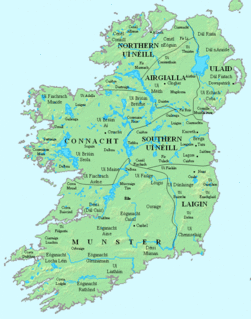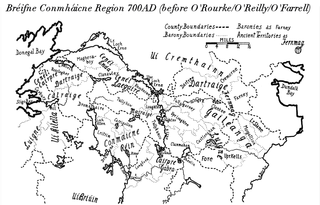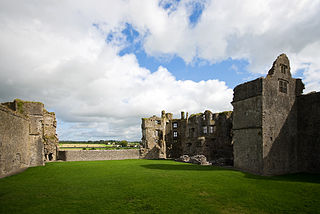
The Delbna or Delbhna was a Gaelic Irish tribe in Ireland, claiming kinship with the Dál gCais, through descent from Dealbhna son of Cas. Originally one large population, they had a number of branches in Connacht, Meath, and Munster in Ireland.
Kerry or Kerri is both a masculine and feminine English language given name of Gaelic (Irish) origin.
Cathal mac Conchobair was King of Connacht.
Rogallach mac Uatach was a king of Connacht from the Uí Briúin branch of the Connachta. He was the son of Uatu mac Áedo, a previous king. He acquired the throne of Connacht after defeating the previous king Colmán mac Cobthaig of the Ui Fiachrach Aidhne, who was slain at the Battle of Cennbag in 622. Professor Francis Byrne believes he is the first reasonable representative of this branch to be said to have held the throne of Connacht
Cenn Fáelad mac Colgan was a King of Connacht from the Uí Briúin branch of the Connachta. He was of the branch which developed into the Uí Briúin Seóla, who were centred on Tuam in modern County Galway. He is the first member of this branch mentioned in the annals.
Muirgius mac Tommaltaig was a King of Connacht from the Uí Briúin branch of the Connachta. He was the great-grandson of Indrechtach mac Muiredaig Muillethan, a previous king. The death of his father Tommaltach mac Murgail is recorded in the annals where he is called king of Mag nAi. Muirgius was of the Síl Muiredaig sept of the Uí Briúin. He reigned from 792 to 815.
Diarmait mac Tommaltaig was a king of Connacht from the Uí Briúin branch of the Connachta. He was the great-grandson of Indrechtach mac Muiredaig Muillethan, a previous king. The death of his father Tommaltach mac Murgail is recorded in the annals where he is called king of Mag nAi. He succeeded his brother Muirgius mac Tommaltaig. He was of the Síl Muiredaig sept of the Uí Briúin. He ruled from 815 to 833.
Máenmaige was originally a kingdom, later termed a trícha cét, and in Anglo-Norman times a cantred, which formed the barony of Loughrea.

Muintir Murchada was the name of an Irish territory which derived its name from the ruling dynasty, who were in turn a branch of the Uí Briúin. The name was derived from Murchadh mac Maenach, King of Uí Briúin Seóla, who died 891.
Muireadhach Ua Flaithbheartaigh was King of Iar Connacht.
Mael Brigte mac Mothlachain, assassin, fl. 649.
The Ciarraige were a population-group recorded in the early historic era in Ireland.
The Cálraighe were a population-group found mostly in northern Connacht as well as County Westmeath and County Longford. They were purported descendants of Lugaid Cal, son of Daire Sirchrechtaig, who was himself a supposed descendant of Lugaid mac Itha, a first cousin of Míl Espáine.

Gailenga was the name of two related peoples and kingdoms found in medieval Ireland in Brega and Connacht.
The Ciarraighe Locha na nÁirne were a branch of the Ciarraighe people, located in what is now central-east County Mayo in Connacht.
The Uí Fiachrach were a dynasty who originated in, and whose descendants later ruled, the coicead or fifth of Connacht at different times from the mid-first millennium onwards. They claimed descent from Fiachrae, an older half-brother of Niall Noigiallach or Niall of the Nine Hostages. Fiachrae and his two full brothers, Brion and Ailill, were the collective ancestors of the Connachta dynasty that eventually became the new name of the province. Their mother was Mongfind.









